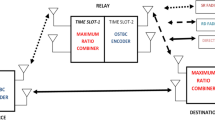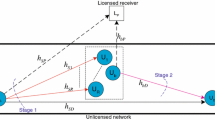Abstract
In this paper, the performance of opportunistic decode-and-forward relaying network over Rayleigh fading channels is analyzed. We assume that the intermediate relay nodes are distributed according to a homogeneous Poisson point process with fixed density. We also consider a sectorized relay selection region to reduce the signaling overhead (e.g., link quality feedback) for establishing reliable connections between the source and destination. The “best relay” is selected among those potential relay nodes that lie in this region such that can achieve the highest signal-to-noise ratio at the destination node. In particular, the density of the potential relay nodes and the closed-form expression for outage probability of the system with maximal ratio combining (MRC) receiver at the destination, is derived based on the theory of point processes. Our results demonstrate that cooperative communication with MRC receiver deliver significant performance gains compared to direct transmission in spatially random networks. Simulation results show the validity of the analysis and point out the effect of key system parameters on the outage probability of the system.




Similar content being viewed by others
Notes
Let \(\nu (x):{\mathbb {R}}^{2}\rightarrow [0,1]\) and \(\int _{{\mathbb {R}}^{2}}{\vert 1-\nu (x)\vert dx}<\infty \). When \(\Phi \) is Poisson of intensity \(\lambda \), the conditional generating functional is \({\mathbb {E}}\{\prod \nolimits _{x\in \Phi }\nu (x)\}=\exp \left( -\lambda \int \nolimits _{{\mathbb {R}}^{2}}[1-\nu (x)]dx\right) \) [18].
References
Laneman, J., Tse, D., & Wornell, G. (2004). Cooperative diversity in wireless networks: Efficient protocols and outage behavior. IEEE Transactions on Information Theory, 50, 3062–3080.
Nosratinia, A., Hunter, T. E., & Hedayat, A. (2004). Cooperative communication in wireless networks. IEEE Communications Magazine, 42(10), 74–80.
Mohammadi, M., Mobini, Z., Ardebilipour, M., & Mahboobi, B. (2013). Performance analysis of generic amplify-and-forward cooperative networks over asymmetric fading channels. Wireless Personal Communications, 72(1), 49–70.
Bletsas, A., Khisti, A., Reed, D., & Lippman, A. (2006). A simple cooperative diversity method based on network path selection. IEEE Journal on Selected Areas in Communications, 24(3), 659–672.
Jing, Y., & Jafarkhani, H. (2009). Single and multiple relay selection schemes and their achievable diversity orders. IEEE Transactions on Wireless Communications, 8(3), 1414–1423.
Xu, F., Lau, F. C. M., Zhou, Q. F., & Yue, D.-W. (2009). Outage performance of cooperative communication systems using opportunistic relaying and selection combining receiver. IEEE Signal Processing Letters, 16(2), 113–116.
Kalantari, A., Mohammadi, M., & Ardebilipour, M. (2011). Performance analysis of opportunistic relaying over imperfect non-identical log-normal fading channels. In Proceedings of IEEE PIMRC (pp. 1909–1913). Toronto, ON, Canada.
Hunter, A. M., Andrews, J. G., & Weber, S. (2008). Transmission capacity of ad hoc networks with spatial diversity. IEEE Transactions on Wireless Communications, 7(12), 5058–5071.
Mohammadi, M., Suraweera, H. A., & Zhou, X. (2012). Outage probability of wireless ad hoc networks with cooperative relaying. In Proceedings of IEEE GLOBECOM (pp. 4410–4416). Anaheim, CA, USA.
Behnad, A., Rabiei, A. M., & Beaulieu, N. C. (2013). Performance analysis of opportunistic relaying in a Poisson field of amplify-and-forward relays. IEEE Transactions on Communications, 61(1), 97–107.
Wang, H., Ma, S., Ng, T.-S., & Poor, H. V. (2011). A general analytical approach for opportunistic cooperative systems with spatially random relays. IEEE Transactions on Wireless Communications, 10(12), 4122–4129.
Altieri, A., Vega, L. R., Galarza, C. G., & Piantanida, P. (2012). Cooperation versus interference in large wireless relay networks. In Proceedings of IEEE ISIT (pp. 611–615). Cambridge, MA, USA.
Ganti, R. K., & Haenggi, M. (2009). Analysis of uncoordinated opportunistic two-hop wireless ad hoc systems. In Procedings of IEEE ISIT 2009 (pp. 1020–1024). Seoul, South Korea.
Zhai, C., Zhang, W., & Mao, G. (2012). Uncoordinated cooperative communications with spatially random relays. IEEE Transactions on Wireless Communications, 11(9), 3126–3135.
Simon, M., & Alouini, M. (2005). Digital communications over fading channels. London: Wiley.
Kingman, J. F. C. (1993). Poisson processes. Oxford: Oxford University Press.
Gradshteyn, I. S., & Ryzhik, I. M. (2007). Table of integrals, series and products (7th ed.). London: Academic Press.
Stoyan, D., Kendall, W., & Mecke, J. (1996). Stochastic geometry and its applications (2nd ed.). London: Wiley.
Author information
Authors and Affiliations
Corresponding author
Rights and permissions
About this article
Cite this article
Razi, M.M., Mohammadi, M., Ardebilipour, M. et al. Outage Probability of Opportunistic Relaying in Poisson Wireless Networks. Wireless Pers Commun 83, 755–764 (2015). https://doi.org/10.1007/s11277-015-2422-2
Published:
Issue Date:
DOI: https://doi.org/10.1007/s11277-015-2422-2




